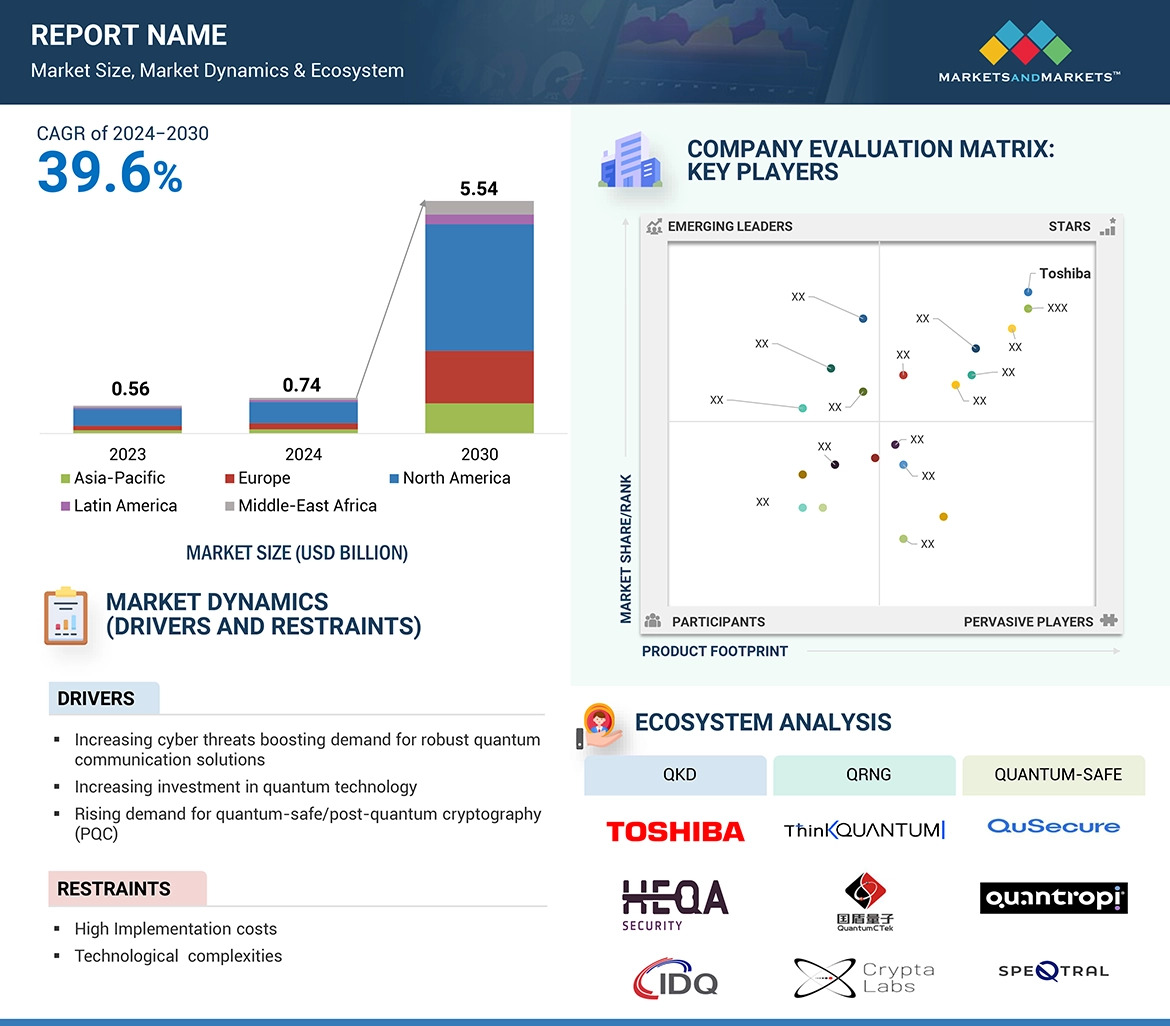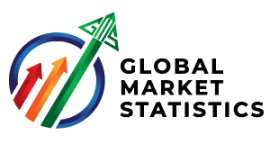The global quantum communication market forecast is projected to grow from USD 0.74 billion in 2024 to USD 5.54 billion by 2030 at a Compound Annual Growth Rate (CAGR) of 39.6% during the forecast period.
Download PDF Brochure@ https://www.marketsandmarkets.com/pdfdownloadNew.asp?id=143942501
Increasing investment in research and development (R&D) from both public and private sectors reflects the strategic importance of quantum technologies. Initiatives like the U.S. National Quantum Initiative and the European Quantum Flagship program focus on advancing quantum communication. Also, the U.S. National Science Foundation is investing USD 39 million in the ExpandQISE program to enhance quantum research at various institutions across America. Hence, this heightened focus on R&D is propelling the adoption of quantum communication solutions across various industries, including telecommunications and finance.
Emerging Trends in Quantum Communication Market:
Quantum Key Distribution (QKD) Adoption: Quantum Key Distribution (QKD) is becoming a primary application in quantum communication, offering highly secure key exchange methods based on quantum mechanics principles. Organizations, especially in finance, defense, and government, are increasingly adopting QKD to protect sensitive data from quantum and classical cyber threats.
Development of Quantum-Secured Networks: Quantum-secured networks are emerging as critical infrastructures, integrating QKD and classical cryptographic systems. These networks enhance data security by securing end-to-end connections, providing a foundation for secure communications in sectors like healthcare, telecom, and financial services.
Hybrid Quantum-Classical Solutions: Many companies are adopting hybrid quantum-classical systems to gradually transition to quantum-safe communications. This approach allows organizations to utilize both quantum and conventional encryption, ensuring enhanced security and easier integration into existing IT infrastructures.
Advancements in Satellite-Based Quantum Communication: Satellite-based quantum communication is progressing, enabling secure, long-distance transmission of quantum information beyond the limitations of terrestrial fiber. With major projects launched by countries like China, this technology aims to facilitate global, secure communication networks resistant to eavesdropping.
Rise of Quantum Communication Protocols for IoT: As IoT devices proliferate, there is a need for secure, scalable communication protocols. Quantum communication protocols are being developed to protect IoT devices against vulnerabilities, ensuring that sensitive data transmitted by these devices remains secure against current and future cyber threats.
Based on the offering, the solution segment accounts for the highest market size during the forecast period.
The solution segment is expected to account for the highest market size during the forecast period. This growth is driven by the increasing demand for advanced security solutions, such as Quantum Key Distribution (QKD) and quantum-encrypted communication channels. As organizations seek to protect sensitive data from evolving cyber threats, the adoption of these solutions is gaining momentum across various sectors, including IT & telecommunications, finance, and government. The providers of quantum communication solution includes Toshiba, ID Quantique, QuintessenceLabs, QuantumCTek, Qubitekk, and Quantum Xchange.
By deployment mode, on-premise segment accounts for the highest market size during the forecast period.
By deployment mode, the on-premise segment is expected to account for the highest market size during the forecast period in the quantum communication market. This is driven by organizations’ need for greater control over data security, particularly in sectors handling sensitive information, such as finance and government. On-premise solutions offer tailored security measures and reduced latency, making them appealing for enterprises looking to enhance their quantum communication capabilities.
By region, Europe will grow at the highest CAGR during the forecast period.
By region, Europe is projected to grow at the highest CAGR during the forecast period in the quantum communication market. This growth is fueled by significant investments in quantum research and innovation, supported by initiatives such as the European Quantum Flagship program. Launched in 2018, the Quantum Flagship is one of the European Union’s largest research initiatives, with a budget of at least €1 billion over 10 years. It unites research institutions, academia, industry, and policymakers in a collaborative effort of unprecedented scale. The UK is at the forefront of the global race in quantum technology through the National Quantum Technologies Programme (NQTP), which unites academia, industry, and government to turn research strengths into commercial advantages.
Key Players
Toshiba (Japan), Thales (France), IDEMIA (France), ID Quantique (Switzerland), QuintessenceLabs (Australia), QuantumCTek (China), Qubitekk (US), Quantum Xchange (US), HEQA Security (Israel), MagiQ Technologies (US), Crypta Labs (UK), SpeQtral (Singapore), QEYnet (Canada), Qulabs (India), Quantropi (Canada), Qudoor (China), QTI SRL (Italy), nodeQ (UK), ThinkQuantum (Italy), Arqit (UK), Aliro Quantum (US), NuCrypt (US), Quantum Opus (US), Ki3 Photonics Technologies (Canada), Miraex (Switzerland), S-Fifteen Instruments (Singapore), QphoX (Netherlands), and Qunnect (US) are the key players and other players in the quantum communication market.
About MarketsandMarkets™
MarketsandMarkets™ has been recognized as one of America’s best management consulting firms by Forbes, as per their recent report.
MarketsandMarkets™ is a blue ocean alternative in growth consulting and program management, leveraging a man-machine offering to drive supernormal growth for progressive organizations in the B2B space. We have the widest lens on emerging technologies, making us proficient in co-creating supernormal growth for clients.
Earlier this year, we made a formal transformation into one of America’s best management consulting firms as per a survey conducted by Forbes.
The B2B economy is witnessing the emergence of $25 trillion of new revenue streams that are substituting existing revenue streams in this decade alone. We work with clients on growth programs, helping them monetize this $25 trillion opportunity through our service lines – TAM Expansion, Go-to-Market (GTM) Strategy to Execution, Market Share Gain, Account Enablement, and Thought Leadership Marketing.
Built on the ‘GIVE Growth’ principle, we work with several Forbes Global 2000 B2B companies – helping them stay relevant in a disruptive ecosystem. Our insights and strategies are molded by our industry experts, cutting-edge AI-powered Market Intelligence Cloud, and years of research. The KnowledgeStore™ (our Market Intelligence Cloud) integrates our research, facilitates an analysis of interconnections through a set of applications, helping clients look at the entire ecosystem and understand the revenue shifts happening in their industry.
To find out more, visit www.MarketsandMarkets™.com or follow us on Twitter, LinkedIn and Facebook.
Contact:
Mr. Rohan Salgarkar
MarketsandMarkets Inc.
1615 South Congress Ave.
Suite 103, Delray Beach, FL 33445
USA: +1-888-600-6441
Email: [email protected]




